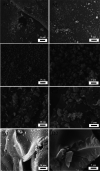Highly Efficient, Environmentally Friendly Lignin-Based Flame Retardant Used in Epoxy Resin
- PMID: 33344863
- PMCID: PMC7745397
- DOI: 10.1021/acsomega.0c05146
Highly Efficient, Environmentally Friendly Lignin-Based Flame Retardant Used in Epoxy Resin
Abstract
We prepared novel flame retardants with concurrent excellent smoke-suppression properties based on lignin biomass modified by functional groups containing N and P. Each lignin-based flame retardant (Lig) was quantitatively added to a fixed amount of epoxy resin (EP), to make a Lig/EP composite. The best flame retardancy was achieved by a Lig-F/EP composite with elevated P content, achieving a V-0 rating of the UL-94 test and exhibiting excellent smoke suppression, with substantial reduction of total heat release and smoke production (by 46.6 and 53%, respectively). In this work, we characterized the flame retardants and the retardant/EP composites, evaluated their performances, and proposed the mechanisms of flame retardancy and smoke suppression. The charring layer of the combustion residual was analyzed using SEM and Raman spectroscopy to support the proposed mechanisms. Our work provides a feasible method for lignin modification and applications of new lignin-based flame retardants.
© 2020 American Chemical Society.
Conflict of interest statement
The authors declare no competing financial interest.
Figures









References
-
- Jin F.; Li X.; Park S. Synthesis and application of epoxy resins: A review. J. Ind. Eng. Chem. 2015, 29, 1–11. 10.1016/j.jiec.2015.03.026. - DOI
-
- Hu Y.; Yuan B.; Cheng F.; Hu X. NaOH etching and resin pre-coating treatments for stronger adhesive bonding between CFRP and aluminium alloy. Composites, Part B 2019, 178, 10747810.1016/j.compositesb.2019.107478. - DOI
-
- Wang S.; Ma S.; Xu C.; Liu Y.; Dai J.; Wang Z.; Liu X.; Chen J.; Shen X.; Wei J.; Zhu J. Vanillin-Derived High-Performance Flame Retardant Epoxy Resins: Facile Synthesis and Properties. Macromolecules 2017, 50, 1892–1901. 10.1021/acs.macromol.7b00097. - DOI
-
- Wu C.; Wang X.; Zhang J.; Cheng J.; Shi L. Microencapsulation and Surface Functionalization of Ammonium Polyphosphate via In-Situ Polymerization and Thiol–Ene Photograted Reaction for Application in Flame-Retardant Natural Rubber. Ind. Eng. Chem. Res. 2019, 58, 17346–17358. 10.1021/acs.iecr.9b02464. - DOI
LinkOut - more resources
Full Text Sources

